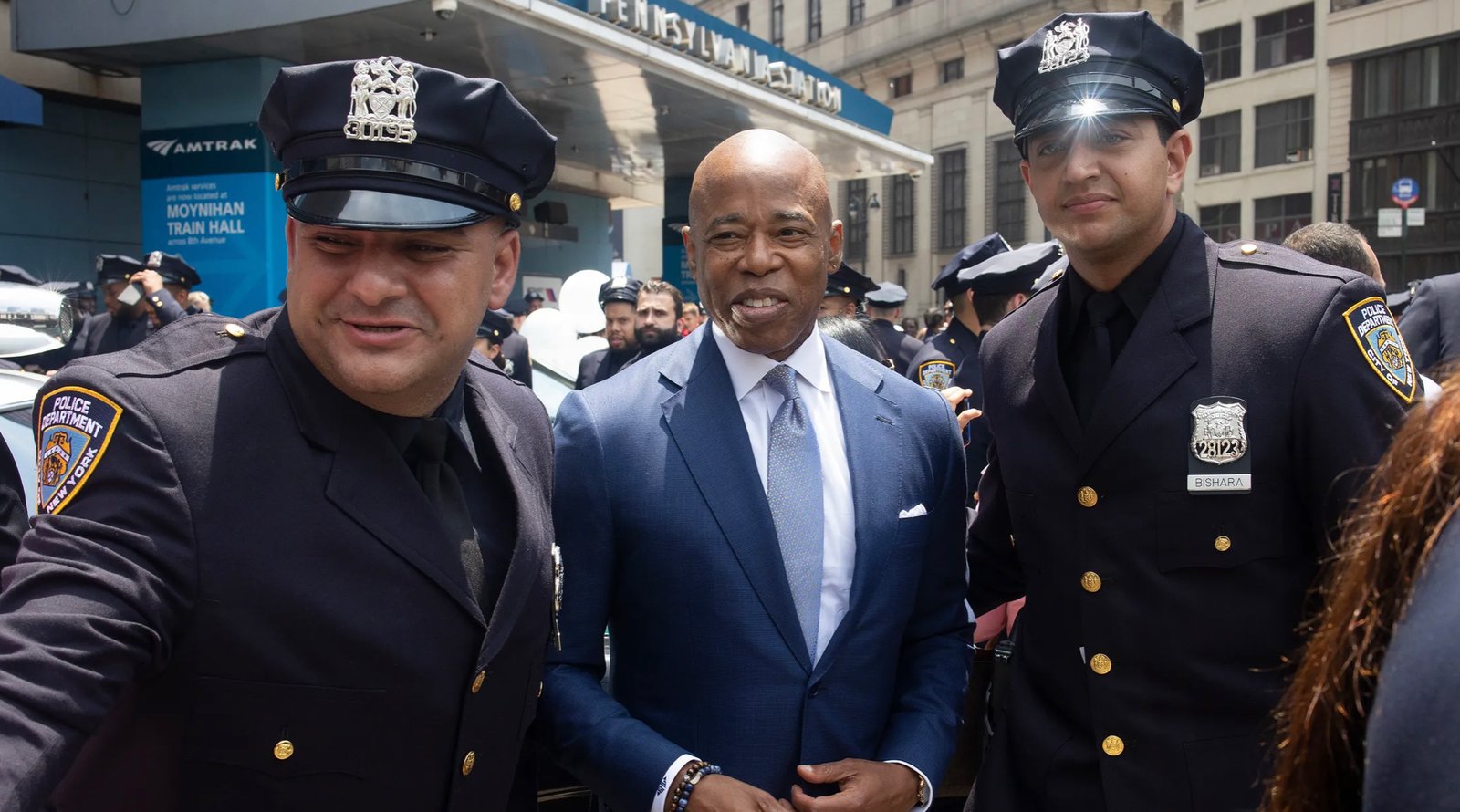The New York City mayor is criticised in this op-ed by news and politics editor Lexi McMenamin for imposing additional police on the city’s most vulnerable residents.
After months of trying to “handle” the city’s homelessness “problem,” New York City Mayor (and likely New Jersey resident) Eric Adams announced on Tuesday that he would be taking yet another step. Former police chief Adams turned to his brothers and sisters in blue for help, rather than, say, following through on his promise to make it easier to access the more than 2,600 vacant apartments the city set aside for the homeless, which appears to be stymied by administrative issues – perhaps because of the intense level of turnover in the admin, but who’s to say.
There is no doubt that this city is experiencing a housing crisis. During the annual HOPE count, where the city tries to count individuals sleeping on the streets, they identified nearly 3,500 people, which they feel is an undercount given the count is done during freezing January. One estimate put the nightly total of those in city-run shelters this year at over 50,000. Americans are worried about their mental health, according to CNN’s summer 2022 survey, which received 9 out of 10 responses. There is a therapist shortage, which is known to anyone who has been involved in or needed mental health care in some form (including me and practically everyone I know). Young and BIPOC consumers are among those who are being disproportionately affected.
Adams firmly retorted, “cops, not care,” when several suggested “care not cops.” According to the New York Times, “…at the conclusion of a year that has witnessed a spate of high-profile crimes involving homeless people, mayor Eric Adams vowed on Tuesday a massive drive to remove persons with serious, untreated mental illness from the city’s streets and subways.” Police will be the ones doing the “removing”—again, of people, not objects. In his address establishing the policy, Adams presented it as a “moral imperative” to “demand involuntarily hospitalising persons who were a danger to themselves, even if they posed no risk of harm to others.” Critics, who the Times categorises as other city officials and “left-leaning advocates”—I wonder what that term means—told the paper that they worried the bad effects that could result from police providing what is purported to be mental health care.
Fox affiliate in NYC reported “City authorities claim that this will be handled on a case-by-case basis because there is no clear definition of who this will apply to.”
The infrastructure to implement this simply isn’t there, according to individuals who work in homeless outreach and assistance who claim that the current system couldn’t manage the people now under its care. They stated this concern to Fox5. Jacquelyn Simone, the policy director of the city’s Coalition for the Homeless, told the Guardian that Mayor Adams “continues to get it wrong when it comes to his dependence on ineffective monitoring, policing, and involuntary transfer and treatment of those with mental illness.”
The Legal Aid Society and the Bronx Defenders, two neighbourhood legal aid organisations, went so far as to denounce the policy when it appeared to be praised in a statement supporting action on the housing issue. The Bronx Defenders’ subsequent tweets state, “Simply put: More policing and forced hospitalisation do not further public health or safety.” “We ask the mayor to retract this programme and substitute investments in long-term, supportive housing and decent, community-based healthcare.”
So who is advocating for this if not housing and legal experts? It is a continuation of our country’s current policy of how to handle those with disabilities, especially those who are mentally ill. Start in New York, please. Kendra’s Law, which permits “court-ordered aided outpatient therapy” for persons judged a safety issue, was passed by New York State in 1999 after a person with a mental illness shoved another person in front of an approaching subway train in New York City, killing them. Those who opposed it said it was a means of punishing people who suffer from mental illness for not following a treatment plan or declining medicine.
The Appeal reported in August 2022 that after enacting “assisted outpatient therapy” (AOT) regulations, which can subject people targeted to penalties if they refuse a state-ordered treatment plan, more than 40 states did the same. Kimberly Mosolf, an attorney with Disability Rights Washington, which opposed the state’s AOT expansion, told the Appeal that “there’s always this rush to force treatment as the answer, but… we don’t have enough treatment resources for folks who specifically are like, “I want these services.” A policy that allows people with certain diseases, such as schizophrenia, to “be placed under a conservatorship and commanded to obey,” was just signed into law by California Governor Gavin Newsom.
Since 2021’s preoccupation on the #FreeBritney movement, which revolved around conservatorships, the topic of what autonomy people experiencing mental health challenges can be expected to receive has been top of mind in our culture. Britney Spears’ struggle to end her own conservatorship served as a major warning to the public about the expectations placed on people with disabilities, particularly those suffering from mental illness, to relinquish all control to the government or other institutions. Disability writer s.e. smith explained for Bitch last year that “conservatorships are basically value judgments, making assessments about someone’s capacity based on assumptions about how they think or move through the world,” which means that any given diagnosis “is taken as an unquestionable indicator that someone is incapable of caring for themselves.”
Perhaps it’s not unexpected that a pop star’s suffering evokes more sympathy than that of a stranger we’ve been taught to mistrust. Additionally, it is presented in “kind” language: This is care; “they” need us to step in and coerce them into seeking treatment; “they” can’t help themselves. Similar ideas were mentioned by Adams during the news conference where the policy was announced. However, this way of thinking carries grave risks that worsen current systemic dynamics.
The case of 20-year-old Alejandro Suarez, who abruptly relocated from his mother’s Florida home to Illinois in order to acquire some independence, is one story from earlier this year that has resonated with me. Due to an early autism diagnosis, his mother and aunt went on to obtain an urgent court order declaring Suarez incompetent. But that wasn’t the only issue; the judge in transphobic Florida was persuaded by the aunt and mother’s strange assertion that Suarez “may have been abducted by a violent band of transgender individuals intending to harvest and sell his body organs.” Suarez retaliated and now makes his own way in Illinois.
Imani Barbarin, a TikTok user and disability rights campaigner, criticised Adams’s policy on Twitter. Eric Adams’ choice to lock up mentally ill individuals “should worry everyone,” Barbarin wrote, pointing out how such judgments “have traditionally been weaponized against dissenters and marginalised people.” Others who disagreed with the policy described how it had personally affected them: “I had to go to the hospital against my will. It was the most horrific experience of my life, even with the loving support of friends and family and health insurance, said Ruth Sangree, a law student at New York University, in a tweet that went viral and has received over 21,600 likes as of the time of writing. “Violence that is beyond your comprehension. It’s a key factor in my decision to support abolition. This is bad.
For Teen Vogue, Sangree elaborated on her points, saying, “The point I was trying to convey is that involuntarily being hospitalised can be incredibly painful even in the greatest of circumstances.” But they are hardly the ideal conditions. I was quite enraged by the criminalization of homeless people and the growth of the police state under the guise of “public health.”



















